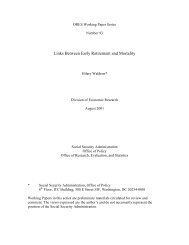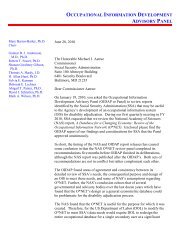Yelin and Trupin (2003) found that workers withdisabilities are more likely to have episodic employmentand employment that is part time. Hotchkiss(2004), however, argues that the increase in the fractionof the population with disabilities engaged in parttimework is largely a voluntary phenomenon. Becausethe relative “attractiveness” of the occupations (interms of O*NET 5 measures of achievement, workingconditions, recognition, relationships, support, andindependence) chosen by individuals with and withoutdisabilities changed little from 1990 to 2000, sheargues that disability policy changes led to increasedpart-time employment among workers with disabilities.However, the author does not consider whether ornot her sample actually received SSI (or DI).DataResearch on the SSI population is largely based onadministrative data or on special surveys of the beneficiarypopulation (for example, the National Surveyof SSI Children and Families (NSCF) or the NationalBeneficiary Survey (NBS)). 6 Administrative datacannot be used for the purposes of the current researchbecause it is necessary to have a nonrecipient comparisongroup with which to compare the occupationaldistributions. Most recipient-specific survey data sharethis common drawback. National surveys, such as theSurvey of Income and Program Participation or theNational Health Interview Survey often do not includea large enough sample of SSI recipients to obtain reliableestimates of occupations given the small fractionof recipients who work. 7The inability of most survey’s to capture a sufficientlylarge SSI population can be partially overcomeby using a sufficiently large data set. The public-useversion of the 2007 American Community Surveyhas a large enough sample size to accurately measurethe SSI occupational distribution. 8 Roughly 3 millioninterviews are conducted annually, divided among the12 months of the year. The ACS is designed to replacethe decennial census long form and provide researchersand administrators information to evaluate programsand compare communities in intercensal years.This study uses the public-use version of the ACS.As part of the section on income in the ACS,individuals are asked to report how much SSI incomethey received in the previous year. This informationwas used to create a binary variable indicating SSIprogram participation in the previous year. The ACSalso includes three sets of disability-related questions,each including two parts. These questions ask if theindividual: 1a) has “blindness, deafness, or a severevision or hearing impairment” (sensory); 1b) “has acondition that substantially limits one or more basicphysical activities such as walking, climbing stairs,reaching, lifting, or carrying” (physical); 2a) has difficulty“learning, remembering, or concentrating” (mental);2b) has difficulty “dressing, bathing, or gettingaround inside the home” (self-care); 3a) has difficulty“going outside the home alone to shop or visit a doctor’soffice” (go outside home); and 3b) has difficulty“working at a job or business” (employment). 9If nonrecipients reported having any one of theseconditions, they are defined as having a self-reporteddisability; otherwise they do not have a self-reporteddisability. This forms two groups of nonrecipients(with and without a disability) whose occupationaldistributions are compared with that of working-ageSSI recipients (who are all disabled according to SSA’srules, but may not have a self-reported disability inthe survey).In addition to the employed working-age SSI populationand the nonrecipient populations with and withoutdisabilities, three other groups of interest are identifiedin the data: (1) nonrecipients with a work-related disability(the “employment” question above) are includedand analyzed separately because this definition ofdisability is most closely aligned with the definition ofdisability used to qualify a working-age individual forSSI payments based on disability; (2) unemployed SSIrecipients are included; and (3) SSI recipients who arenot participating in the labor force are also included inthe data to inform policy options regarding return towork among the nonemployed SSI population. 10If employed, respondents to the ACS write indescriptions of their occupations (type of work andmost important activities and duties), which are codedby ACS contractors into Standard Occupational Classification(SOC) codes. The 509 identified occupationscan be collapsed into 22 major occupational groups,not including unemployment or military-specificcodes, according to the Standard Occupational ClassificationManual: 2000. 11 For the most part, the SOCgroupings are maintained throughout the article. Thereare, however, two exceptions. First, all construction,extraction, maintenance, and repair occupations arecollapsed into a single group because of the smallnumber of SSI recipients in extraction occupations.Second, computer and mathematical occupations;architecture and engineering occupations; and life,physical, and social science occupations are collapsedinto a single group because of small cell sizes in the50 <strong>Social</strong> <strong>Security</strong> Bulletin • Vol. 69 • No. 3 • 2009
prediction models. Table A-1 lists the occupationgroups used in this study along with their codes.Sample RestrictionsThe data are limited to individuals aged 18–61. Bylimiting the data to those in this age range, most earlyretirees and individuals adjusting their employmentin preparation for retirement are excluded from thesample. The unweighted sample for the bulk of theanalysis includes 1,256,019 employed individuals:2,745 SSI recipients; 72,686 nonrecipients with disabilities(including 18,414 with work disabilities); and1,180,588 nonrecipients without disabilities. Theseindividuals are all currently employed in nonmilitaryoccupations. Additionally, there are 861 unemployedSSI recipients and 30,009 SSI recipients who are notparticipating in the labor force.Non-SSI recipients who receive Old-Age, Survivors,and Disability Insurance (OASDI) benefits or RailroadRetirement (RR) benefits are excluded from this analysis.The ACS questionnaire does not distinguish theprogram in which these individuals are participating;although the majority of these individuals are likely tobe disabled workers under the DI program covered by<strong>Social</strong> <strong>Security</strong>, this cannot be identified with precision.Additionally, this group is likely systematicallydifferent from the non-SSI population because of therequirement that earnings remain under substantialgainful activity for OASDI beneficiaries. This mayresult in those beneficiaries being relegated to certainoccupations. As a result, the usefulness of theresults combining OASDI/RR beneficiaries with thenonrecipient populations with or without disabilitiesfor determining which occupations are most useful inhelping individuals become self-sufficient may be limited.SSI recipients who concurrently receive OASDIor RR benefits are retained in the sample. 12Limitations of the DataThere are three main limitations to the data. First,the quality of reported SSI and <strong>Social</strong> <strong>Security</strong> (orOASDI) receipt in survey data has long been known tobe subject to reporting errors. Huynh, Rupp, and Sears(2002), for example, have shown that in the SIPP, SSIrecipients report SSI payments only 80 percent of thetime. The accuracy of the ACS instrument regardingSSI receipt has not been assessed. Some individualsmay report no income from these sources even thoughthey received payments (or vice versa). This could bedue to recall failure or confusion on the months askedabout in the survey. Additionally, some recipientsmay confuse SSI payments with <strong>Social</strong> <strong>Security</strong> (orOASDI) benefits. Because the accuracy of the surveyreports is uncertain, these numbers should be takenwith some degree of caution.Second, recipients are defined as having positiveincome from SSI sometime in the previous 12 months.Because of this, they may have been off of the programrolls for the better part of a year and have anoccupation that pays significantly higher amounts thanthe average reported by SSA.Finally, there are also issues with the measurementof disability in surveys. Most previous research hasfocused on individuals with a work-based disability.However, it is known that work-disability measures insurveys miss a large proportion of the population withdisabilities. Additionally, it is not clear if the presenceof a self-reported work disability reflects a work environmentthat limits work or an impairment that limitswork. See Bound (1991), Hale (2001), National Councilon Disability (2002), Burkhauser, Daly, and Houtenville(2002), and Burkhauser and Stapleton (2003) fora discussion of these issues in the literature. By usingboth the work-based and broad measure of disability,the current analysis allows for multiple concepts ofdisability to be assessed.MethodologyThe first step in assessing differences in the occupationaldistributions is to obtain estimates of the actualoccupational distribution of each group. In addition, acommon measure of market concentration, known asthe Herfindahl-Hirschman index (HHI), is estimated.This is calculated by summing the square of eachoccupation’s share of the distribution. The higherthe HHI, the more concentrated the distribution. Inan economy where there is only one occupation, themaximum HHI of 10,000 is reached. In an economyof J occupations, where each occupation is equallyrepresented, the minimum HHI, J*(100*(1/J)) 2 , isattained. In this case, there are 19 occupation classes,so the minimum HHI is 526.The (dis)similarity of occupations between areference group and each of the remaining groups ismeasured using the dissimilarity index proposed byDuncan and Duncan (1955):J(1) D = å 1 Aj- B2j=1j,where j identifies each occupation and A j(B j) is theproportion of the group A(B) in occupation j. Thissimple measure can be interpreted as the proportion of<strong>Social</strong> <strong>Security</strong> Bulletin • Vol. 69 • No. 3 • 2009 51
- Page 1 and 2:
Social SecuritySocial SecurityBulle
- Page 3:
Social SecurityBulletin Vol. 69, No
- Page 6 and 7: Perspectives77 An Empirical Study o
- Page 8 and 9: Selected Abbreviations—continuedM
- Page 10: within the next few years (Aglira 2
- Page 14 and 15: coverage varies significantly by ra
- Page 16 and 17: non-Hispanic white, and college edu
- Page 18 and 19: same groups (Table 6). For the last
- Page 20 and 21: from DB to DC pensions is accelerat
- Page 22 and 23: Table 8.Percent of individuals who
- Page 24 and 25: not necessarily the largest gains a
- Page 26 and 27: shoring-up DB plans before those pl
- Page 28 and 29: Table B-1.Percent change in mean pe
- Page 30 and 31: Table B-3.Percent of individuals wh
- Page 32 and 33: ReferencesAaronson, Stephanie, and
- Page 35 and 36: Social Security Administration’s
- Page 37: Chart 1.Historical expansion of Soc
- Page 40 and 41: self-employment information for the
- Page 42 and 43: (Cronin 1985). The final earnings r
- Page 44 and 45: prior to 1950, first year of earnin
- Page 46 and 47: average indexed monthly earnings (A
- Page 48 and 49: 13For an explanation of how the sel
- Page 50 and 51: Kopczuk, Emmanuel Saez, and Jae Son
- Page 53 and 54: Occupations of SSI Recipients Who W
- Page 55: on the differences between the occu
- Page 59 and 60: Occupational Distributions of theEm
- Page 61 and 62: similar, only 4 percent of the popu
- Page 63 and 64: Table 5.Estimated occupational dist
- Page 65 and 66: Table 7.Predicted Herfindahl-Hirsch
- Page 67 and 68: Table 9.Estimated occupational dist
- Page 69 and 70: Table 11.Average annual wages of wo
- Page 71 and 72: Table A-2.Means and standard errors
- Page 73 and 74: Table A-3.Coefficients and standard
- Page 75 and 76: Table A-3.Coefficients and standard
- Page 77 and 78: Table A-3.Coefficients and standard
- Page 79 and 80: management, professional, and relat
- Page 81: Stapleton, David C., Nanette Goodma
- Page 84 and 85: Selected Abbreviations—continuedO
- Page 86 and 87: The 1983 Amendments to the Social S
- Page 88 and 89: Chart 1.Proportion of new claimants
- Page 90 and 91: Table 4.The evolution of the ARF an
- Page 92 and 93: for the test of equality of means b
- Page 94 and 95: Table 8.Average monthly Social Secu
- Page 96 and 97: in the chart, especially for men, t
- Page 98 and 99: 6This is a very important character
- Page 100 and 101: Benítez-Silva, Hugo, Berna Demiral
- Page 103 and 104: OASDI and SSI Snapshot andSSI Month
- Page 105 and 106: Monthly Statistical Snapshot, Augus
- Page 107 and 108:
Table 2.Recipients, by eligibility
- Page 109 and 110:
SSI Federally Administered Payments
- Page 111 and 112:
Table 7.Average monthly payment, by
- Page 113:
Awards of SSI Federally Administere
- Page 116 and 117:
Copyright—Authors are responsible
- Page 119 and 120:
Program Highlights, 2009Old-Age, Su








